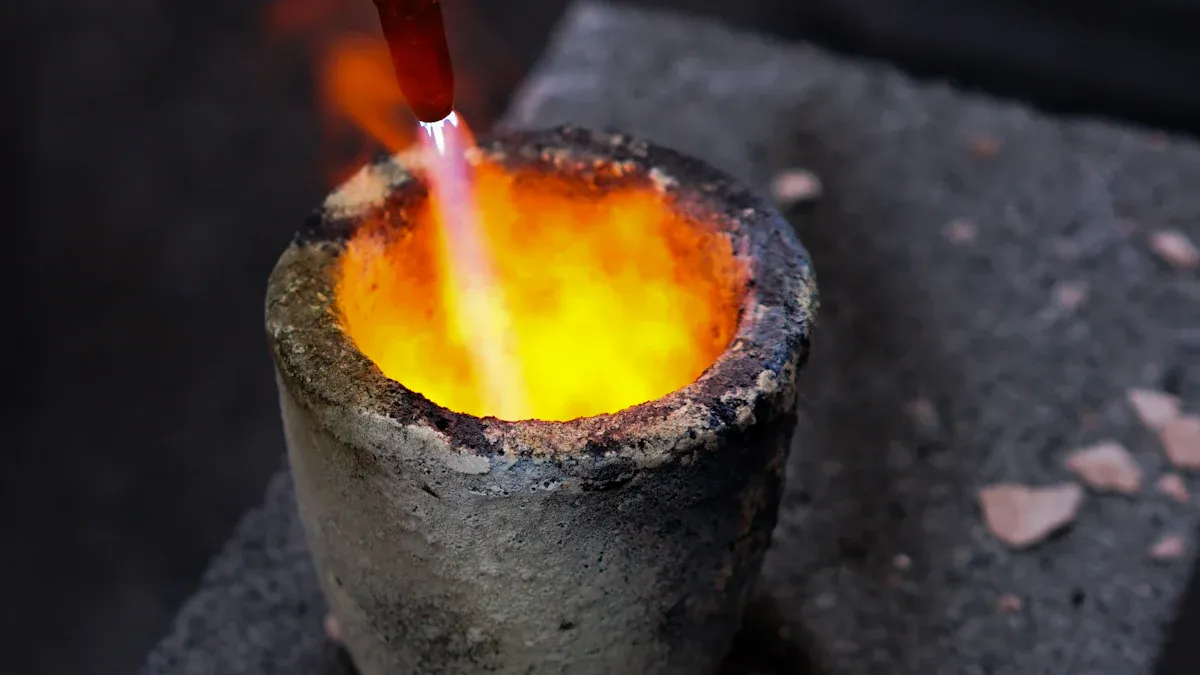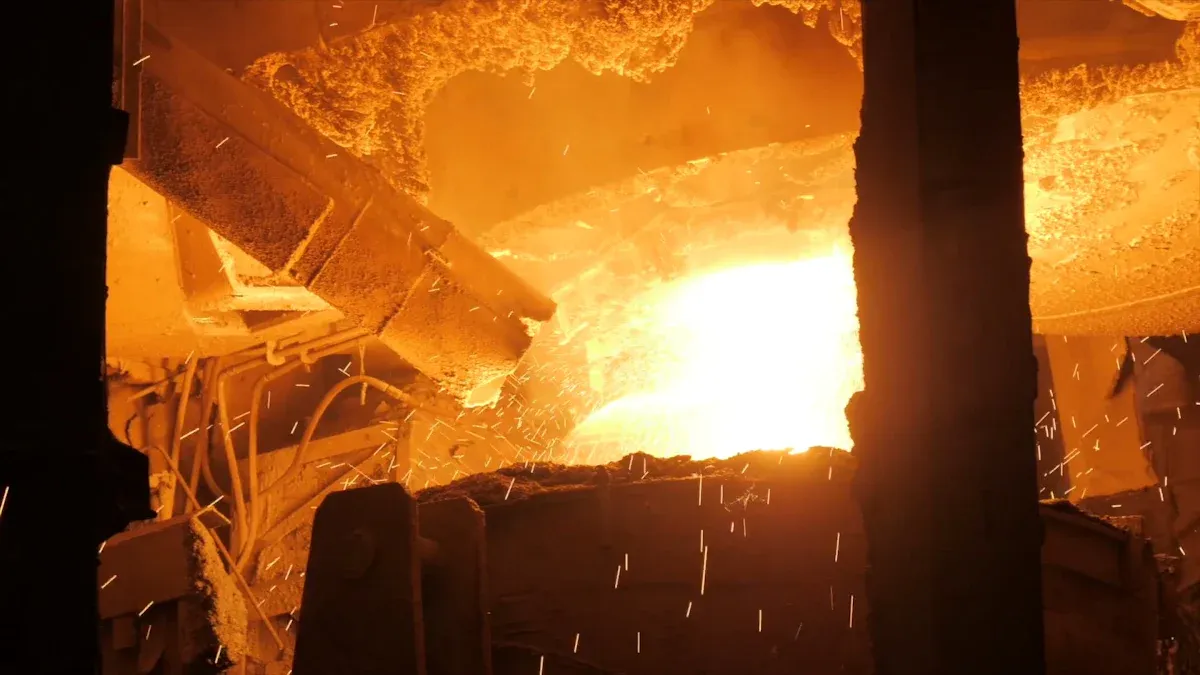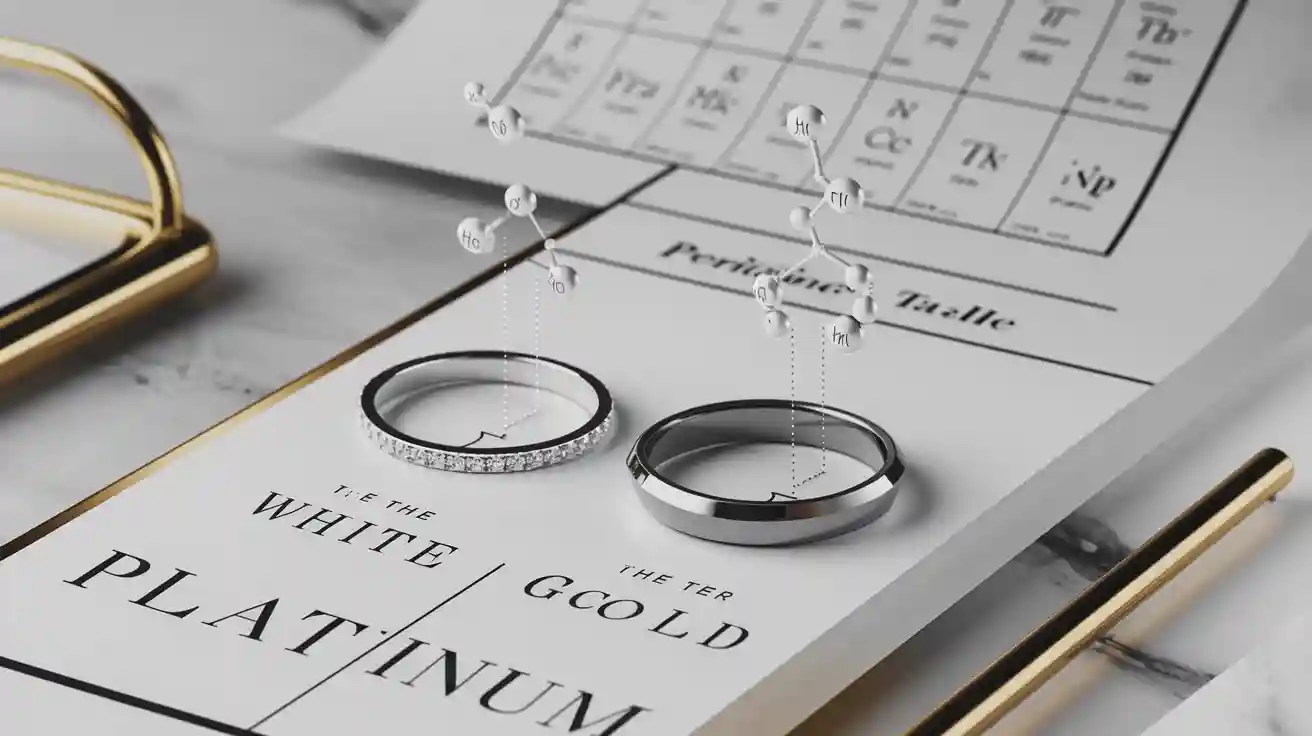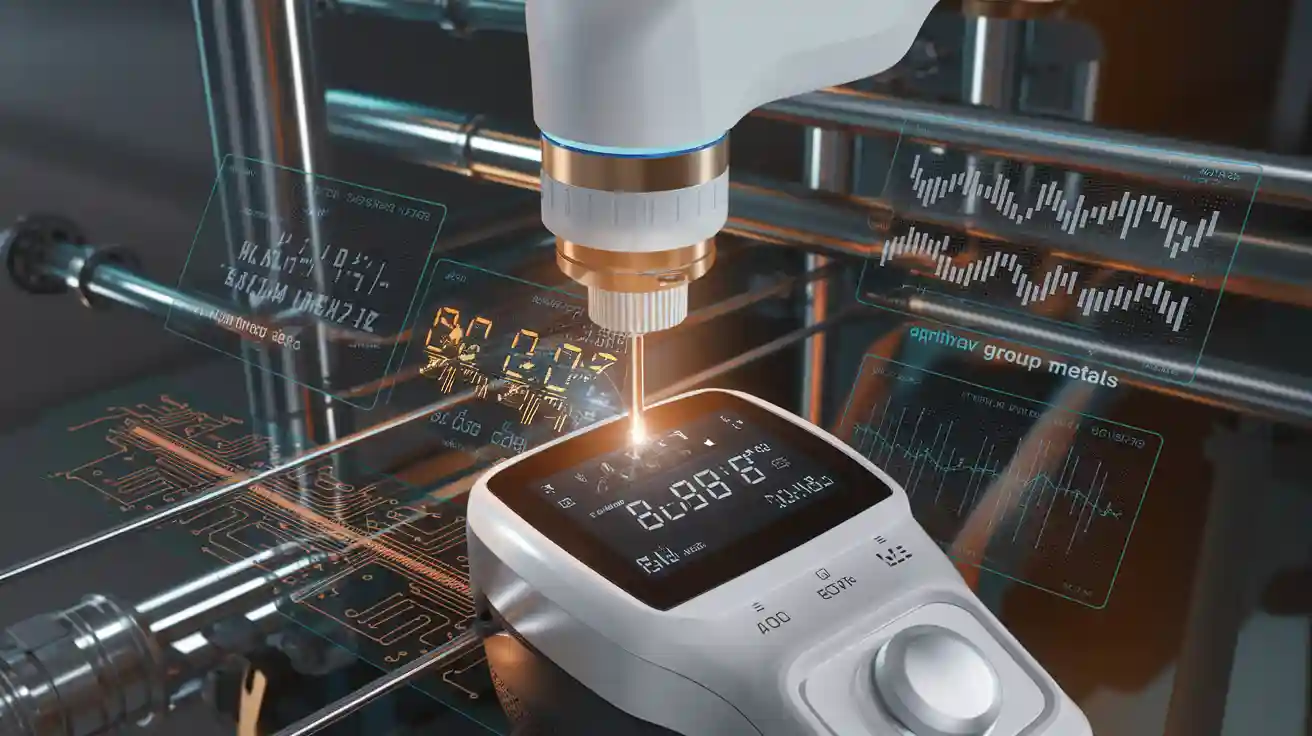
Oro content distribution plays a vital role in the gold melting industry. Even gold content helps ensure high purity, which increases value and meets strict industry standards.
High purity gold often reaches levels of 99.5%, 99.9%, or even 99.99%.
The electronics and jewelry sectors rely on this purity for quality and performance.
Leading producers refine gold to maintain low impurity levels, often below 5%.
Advanced refining and analysis methods help meet these demands and support genuine quality.
Conclusiones clave
Gold purity depends on even distribution during melting and careful control of temperature and pouring methods.
The Miller and Wohlwill processes refine gold to high purity levels, with Wohlwill reaching up to 99.99%.
Accurate gold analysis starts with proper sampling and uses methods like fire assay, acid testing, and advanced instruments.
Modern technologies, incluido XRF and nanotechnology, improve gold detection and ensure quality standards.
Strict quality control and best practices reduce melt loss, maintain purity, and build trust in the gold industry.
Gold Content in Melting

Distribution During Melting
Gold melts at a high temperature, and the way gold content spreads during this process can change based on several conditions. When gold melts, it does not always mix perfectly. Scientists have measured how gold moves between vapor and brine phases at different pressures and temperatures. The table below shows how gold content changes under these conditions:
Parameter | Condition/Range | Gold Content / Partition Coefficient |
|---|---|---|
Temperatura | 800°C | – |
Pressure | 145 MPA | Vapor gold concentration: 36 μg/g |
Pressure | 110 MPA | Vapor gold concentration: 5 μg/g |
Pressure | 145 MPA | Brine gold concentration: 50 μg/g |
Pressure | 110 MPA | Brine gold concentration: 28 μg/g |
Pressure decrease (145 Para 110 MPA) | 800°C | Vapor:Brine gold partition coefficient drops from 0.72 Para 0.17 |
This data shows that as pressure drops, the amount of gold in vapor and brine also drops. The way gold content divides between vapor and brine changes, which affects how much gold stays in the melt. Ultrafast X-ray diffraction experiments have shown that gold atoms move slowly from solid to liquid during melting. The melt front moves through the gold, and the atoms spread out, creating a liquid structure. This process helps explain how gold content can become uneven if the melting is not controlled.
Factors Affecting Uniformity
Many factors can change how evenly gold content spreads during melting. Scientists have found that the shape of the gold surface, called surface curvature, plays a big role. Here are some key points:
Surface curvature of the gold template affects how thick the gold layer is.
Smaller surface curvature leads to smaller thickness changes in the gold shell.
When thickness changes are small, el melting process becomes more even.
If the melting is uneven, gold particles can move away from their original spots, making the gold less uniform.
A veces, gold particles can join together during heating, which makes the gold content even less even.
Nota: The way gold is poured and the shape of the mold also affect how gold content spreads. If the mold has sharp corners or the gold is poured too quickly, impurities and gases can get trapped, causing unevenness.
Melt Loss and Impurities
During melting, some gold can be lost, and impurities can enter the melt. Several things can cause this:
High casting temperatures can make gold grains larger and softer, but do not change how easy it is to roll or bend the gold.
Impurities like iron, tin, bismuth, and antimony can change how gold behaves when it melts and cools.
Deoxidizers such as phosphorus and calcium boride help remove unwanted gases and oxides, making the gold cleaner.
Gases can dissolve in molten gold but escape when the gold cools, causing bubbles or holes.
The way gold is poured and the size of the mold can change how impurities spread and how much gold is lost.
Gold content can drop if too much gold sticks to the sides of the melting pot or if gases carry gold away. Careful control of temperature, pressure, and pouring methods helps reduce melt loss and keeps gold content high.
Refining Processes
Miller Process
The Miller process uses chlorine gas to refine gold. Workers heat impure gold until it melts. They then bubble chlorine gas through the liquid. Base metals and silver react with the gas and form a layer on top. This layer can be removed easily. The Miller process is fast and simple. It produces gold with a purity of about 99.5%. Refineries often use this method first because it removes most impurities quickly. Sin embargo, it does not reach the highest purity levels.
The Miller process is efficient but stops at 99.5% pureza. Refineries often use another method to reach higher purity.
Refining Method | Maximum Gold Purity Achieved |
|---|---|
Miller Process | 99.5% |
Wohlwill Process | 99.99% |
Wohlwill Process
The Wohlwill process uses electricity to refine gold even further. In this method, gold from the Miller process becomes the anode in an electrolytic cell. An acid solution acts as the electrolyte. When electricity passes through the cell, pure gold leaves the anode and collects on the cathode. This process can produce gold with a purity of 99.99%.
The Wohlwill process is slower than the Miller process, but it creates the purest gold used in electronics and investment bars.
A table below shows why these traditional refining methods remain popular:
Métrico | Value/Description |
|---|---|
Total Gold Recovery | |
Gold Purity | At least 99.99% Au-purity in refined gold |
Process Time | Short process duration ensuring efficiency |
Inventory of Gold in Process | Low inventory of gold bound in the refining process |
Refining Method | Purely hydrometallurgical process (oxidative leaching and selective precipitation) |
Safety and Environmental | Safe working environment with no toxic gas emissions |
Operational Experience | Over 30 years of development and global application with capacities from 1 Para 50 tons annually |
Advantages over Pyrometallurgy | Higher direct recovery, safer environment, and efficient handling |
Ensayo de fuego
El ensayo de fuego method helps measure how much gold is in a sample. Workers mix the sample with lead and other chemicals, then heat it in a furnace. Gold and other precious metals collect in a small bead. They weigh this bead to find out how much gold was in the sample. Fire assay is very accurate. Repeatability error margins range from 0.031 Para 0.038 grams per ton. Reproducibility errors are between 0.0093 y 0.014 grams per ton. The total uncertainty is about 12% for a 1-gram sample.
Fire assay is reliable, but it needs skilled workers and larger samples. It also uses lead, which requires careful handling.
Gold Analysis Methods

Sampling Techniques
Accurate gold analysis starts with proper sampling. Workers must collect samples that truly represent the entire batch. They often use induction furnaces to melt gold and silver doré receipts. This method ensures that the sample reflects the real gold content of the whole melt. If the sample does not match the batch, the analysis will not be reliable.
Sampling can happen in the laboratory or on-site. In the lab, technicians use precise tools to cut or drill small pieces from larger bars or ingots. On-site, they might scoop molten gold directly from the furnace. Both methods require careful handling to avoid contamination. Even a small mistake can change the results.
Propina: Always use clean tools and containers when collecting gold samples. This practice helps prevent errors and keeps results trustworthy.
Purity Testing
After collecting a sample, technicians test its purity. Several methods exist for this purpose. The fire assay remains one of the oldest and most trusted techniques. Workers mix the sample with lead and other chemicals, then heat it in a furnace. Gold and other precious metals form a bead, which they weigh to determine purity. This method provides high accuracy but takes time and skill.
Acid testing offers a faster way to check gold purity. Technicians scratch the gold sample on a stone and apply different acids. Each acid reacts with certain gold purities. The reaction tells the technician how pure the gold is. Acid testing works well for quick checks but does not match the accuracy of laboratory methods.
Modern laboratories use advanced testers based on the Archimedean principle, also known as the buoyancy method. These testers measure gold purity with extreme precision. The table below shows some popular models and their features:
Tester Model | Maximum Weight Capacity | Purity Accuracy/Precision | Método de medición |
|---|---|---|---|
TTD-1200K | 1200gramo | 100% | Buoyancy method (Archimedean principle) |
TTD-153K | 300g or 600g | 100% | Buoyancy method (Archimedean principle) |
TTD-214K | 210gramo | 100.0% | Buoyancy method (Archimedean principle) |
These testers achieve 100% accuracy and precision. They eliminate human error and provide consistent results. Laboratories also use Fluorescencia de rayos X (XRF) and Laser-Induced Breakdown Spectroscopy (Libraciones) for even more reliable measurements. These methods help ensure that gold content meets industry standards.
Advanced Technologies
Technology has changed how experts analyze gold. Modern instrumental methods now work alongside traditional techniques. X-ray spectroscopy, spark-emission spectroscopy, and inductively-coupled plasma spectroscopy allow technicians to check for almost every element in a gold sample. These tools make it easier to spot impurities and confirm gold content.
Induction furnaces help create representative samples for analysis.
The Miller process and improved electrorefining methods increase speed and recovery rates.
High-speed silver-electrolysis plants boost refining efficiency and quality.
These advances improve accuracy, seguridad, and compliance with environmental rules.
Nanotechnology has also made a big impact. Gold nanoparticles now play a role in surface-enhanced Raman spectroscopy (SERS). This method detects gold at very low concentrations. Nanomaterials have led to portable devices for fast on-site testing. Nano-sensors and nano-column chromatography improve detection and separation. Experts believe that nanotechnology brings ultra-sensitive detection and unmatched precision to gold analysis.
Nota: The combination of traditional and new technologies helps the gold industry meet strict quality control standards. Accurate analysis protects both producers and buyers by ensuring fair value and compliance.
Control de calidad
Ensuring Accurate Gold Content
Quality control in the gold melting industry relies on strict benchmarks and standards. Refineries use certified standard samples to check the accuracy of their gold assays. They compare the results to certified values using statistical tests. Field and pulp duplicates help monitor precision. External laboratories analyze at least 5% of duplicates to ensure unbiased results. Standards remain anonymous to prevent analyst bias. The table below shows common benchmarks and methods:
Benchmark/Standard | Descripción |
|---|---|
Certified Standard Samples | Assess accuracy by comparing assay means to certified values |
Statistical t-test | Detects significant differences or biases |
Field Duplicates | 5-10% of samples duplicated for precision control |
Pulp Duplicates | 3-5% of pulp samples duplicated |
Standard Reference Materials | 3-5% included in each batch to detect bias |
External Laboratory Analysis | At least 5% of duplicates analyzed externally |
Coefficient of Variation (CV) | Measures relative precision error |
Random Placement of Duplicates | Avoids systematic bias |
Anonymity of Standards | Prevents analyst bias |
Overcoming Challenges
Maintaining even gold content and minimizing melt loss present ongoing challenges. Variability in grain size and distribution can affect counting and purity. Por ejemplo, reference material AuGC-1 shows an average of 38 gold grains per 1.5 grams, but the standard deviation is 10 grains. Most grains are smaller than 50 micrometers, and half are under 20 micrometers. Very fine grains, especially those under 10 micrometers, are hard to count. This natural variability makes quality control more complex. Refineries use these reference materials to develop better methods and validate their results.
Prácticas recomendadas
Refineries follow best practices to control the melting process and improve purity. They use precise temperature control to avoid excessive melt loss. Careful alloying reduces impurities. Meticulous refining techniques, such as cupellation and aqua regia, remove unwanted elements. Continuous monitoring helps maintain high quality and minimize waste. The table below lists melting points for common gold alloys:
Gold Alloy | Karat Purity | Melting Point (°C) |
|---|---|---|
24K Gold | 100% Oro | 1064 |
18K Gold | 75% Oro | 900-950 |
14K Gold | 58.3% Oro | 800-850 |
Technicians use advanced tools to support these practices:
Differential Scanning Calorimetry (DSC) for precise temperature measurement
Hot-Stage Microscopy for visual observation of melting
Thermal Gravimetric Analysis (TGA) for detecting phase transitions
These methods help maintain optimal melting conditions, reduce melt loss, and improve gold content purity.
Careful control of gold content distribution and reliable analysis methods help the industry achieve high purity and value.
Best practices and advanced technologies support strict industry standards.
Ongoing attention to quality control and compliance builds trust and ensures lasting value for producers and buyers.
Consistent quality control protects both the reputation and the future of the gold melting industry.
Preguntas más frecuentes
What causes uneven gold content during melting?
Uneven gold content often results from poor temperature control or fast pouring. Surface shape and trapped gases also play a role. Technicians use careful heating and slow pouring to help gold mix evenly.
How do refineries oro pureza?
Refineries use fire assay, acid testing, and advanced machines like Fluorescencia de rayos X (XRF). These methods check gold content and spot impurities. Each method offers different speed and accuracy.
Why is sampling important in gold analysis?
Sampling ensures the test sample matches the whole batch. Accurate sampling prevents errors in purity results. Workers use clean tools and careful methods to collect samples.
What is melt loss, and how can it be reduced?
Melt loss means gold disappears during melting. High temperatures, trapped gases, or sticking to the pot can cause loss. Refineries lower melt loss by controlling temperature and using special pouring techniques.
Which technologies improve gold analysis today?
Modern labs use XRF, Espectroscopía de desglose inducida por láser (Libraciones), and nanotechnology. These tools give fast, Resultados precisos. Portable devices now allow on-site testing for quick checks.







WhatsApp
Escanea el código QR para iniciar un chat de WhatsApp con nosotros.